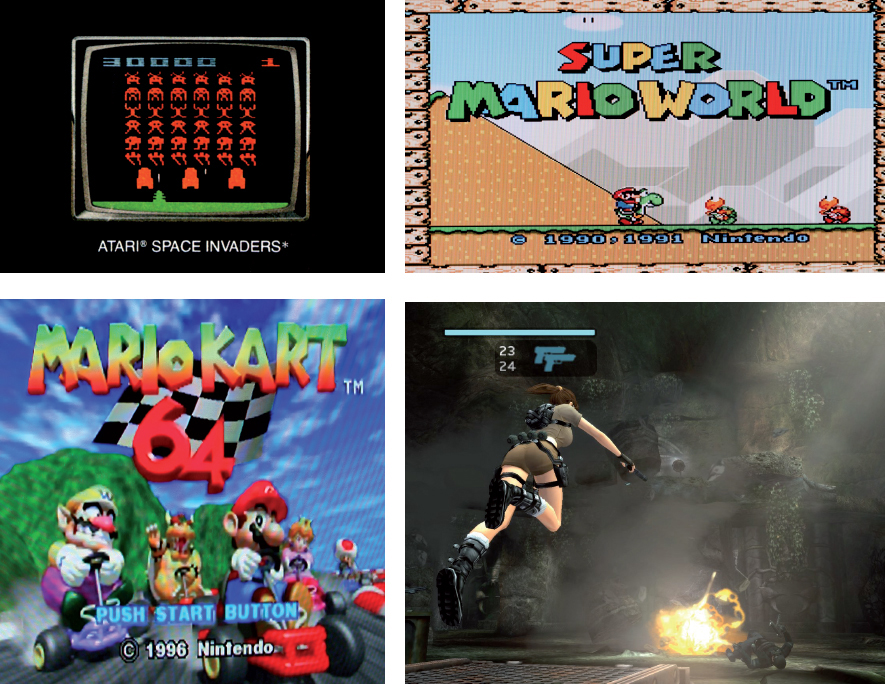Consoles and Advancing Graphics
Printed Page 298
Today, many electronic games are played on home consoles, devices people use specifically to play video games. These systems have become increasingly more powerful since the appearance of the early Atari consoles in the 1970s. One way of charting the evolution of consoles is to track the number of bits (binary digits) that they can process at one time. The bit rating of a console is a measure of its power at rendering computer graphics. The higher the bit rating, the more detailed and sophisticated the graphics. The Atari 2600, released in 1977, used an 8-bit processor, as did the wildly popular Nintendo Entertainment System, first released in Japan in 1983. Sega Genesis, the first 16-bit console, appeared in 1989. In 1992, 32-bit computers appeared on the market; the following year, 64 bits became the new standard. The 128-bit era dawned with the marketing of Sega Dreamcast in 1997. With the current generation of consoles, 256-bit processors are the standard.
But more detailed graphics have not always replaced simpler games. Nintendo, for example, offers many of its older, classic games for download onto its newest consoles even as updated versions are released, for nostalgic gamers as well as new fans. Perhaps the best example of enduring games is the Super Mario Bros. series. Created by Nintendo mainstay Shigeru Miyamoto in 1983, the original Mario Bros. game began in arcades. The 1985 sequel, Super Mario Bros., developed for the 8-bit Nintendo Entertainment System, became the best-selling video game of all time. It held this title until as recently as 2009, when it was unseated by Nintendo's Wii Sports. Graphical elements from the Mario Bros. games, like the "1-Up" mushroom that gives players an extra life, remain instantly recognizable to gamers of many ages. Some even appear on nostalgic T-shirts, as toys and cartoons, and in updated versions of newer games.
Through decades of ups and downs in the electronic gaming industry (Atari closing down, Sega no longer making video consoles), three major home console makers emerged: Nintendo, Sony, and Microsoft. Nintendo has been making consoles since the 1980s; Sony and Microsoft came later, but both companies were already major media conglomerates and thus well positioned to support and promote their interests in the video game market. Veteran electronics manufacturer Sony has the second most popular console, its PlayStation series, introduced in 1994. Its current console, the PlayStation 3 (PS3), boasts more than forty million users on its online PlayStation Network. Microsoft's first foray into video game consoles was the Xbox, released in 2001 and linked to the Xbox Live online service in 2002. Xbox Live lets its twenty million subscribers play online and enables users to download new content directly to the console-the Xbox 360. In 2010, this was the world's third most popular console.
Nintendo released its most recent console, the Wii, in 2006. The device supports traditional video games like the New Super Mario Bros. However, its unique wireless motion-sensing controller takes the often-sedentary nature out of video gameplay. Games like Wii Sports require the user to mimic the full-body motion of bowling or playing tennis, while Wii Fit uses a wireless balance board for interactive yoga, strength, aerobic, and balance games. Although the Wii has lagged behind Xbox and PlayStation in establishing an online community, it is now the best-selling of the three major console systems.
Advances in graphics and game play have also enhanced smaller handheld consoles. Nintendo's Game Boy, a two-color handheld console introduced in 1989, was one early success, selling far more than the competing Sega Game Gear and Atari Lynx, even though those two systems included full-color graphics. For many players, cutting-edge graphics on handheld consoles were-and remain-second in importance to convenience and simplicity. Nonetheless, the early handhelds gave way to later generations of devices offering more advanced graphics and wireless capabilities. These include the Nintendo DS and the PlayStation PSP, as well as simpler games played on smartphones and other mobile devices. Handheld video games have made the medium more accessible and widespread. Even people who wouldn't identify themselves as gamers may kill time between classes or waiting in line by playing Angry Birds on their phones. (See "Converging Media Case Study: Consoles, Portables, and Entertainment Centers.")
